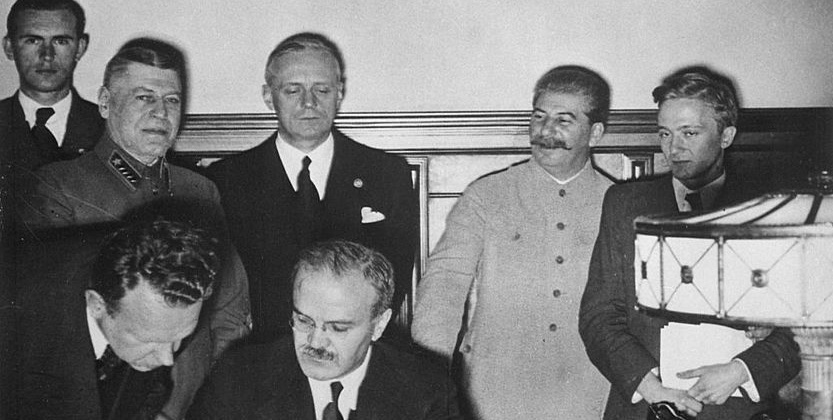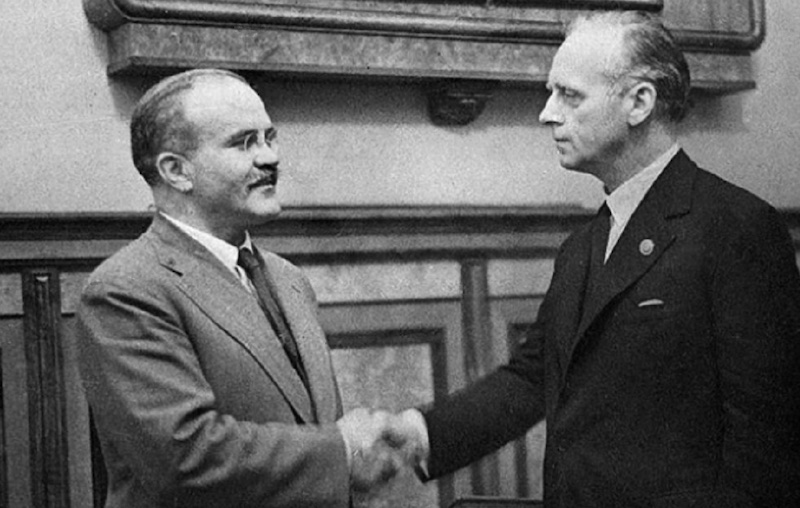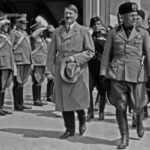We explain what the Pact of German-Soviet Aggression or Ribbentrop-Molotov pact was. In addition, its objectives and consequences.

What was the Pact of German-Soviet aggression?
The Pact of German-Soviet Aggression, also called the Ribbentrop-Molotov Pact, was Un Agreement signed between Nazi Germany and the Soviet Union (USSR) on August 23, 1939. Its main architects were the foreign ministers of both countries: Joachim von Ribbentrop and Viacheslav Molotov.
The pact guaranteed that the Soviet government did not intervene militarily before the German invasion of Poland which occurred a few days later and began World War II (1939-1945). The pact also included a secret clause that agreed to the Soviet invasion of the East of Poland and the cast of Eastern Europe in areas of influence between Germany and the Soviet Union.
The pact was without effect when Germany began the invasion of the Soviet Union On June 22, 1941. In July 1941, the Soviet government signed an agreement with the United Kingdom for which both countries promised to combat together against Germany.
- See also: Background of World War II
Frequent questions
What was the Pact of German-Soviet aggression?
The Pact of German-Soviet aggression was an agreement signed by the governments of Nazi Germany and the Soviet Union on August 23, 1939, a few days before the beginning of World War II. It was a commitment not to attack each other, which allowed Germany to invade Poland without the Soviet Union intervened. Poland's invasion caused the beginning of World War II.
Who signed the Pact of German-Soviet aggression?
The Pact of German-Soviet aggression was signed in Moscow by the Foreign Ministers of Nazi Germany and the Soviet Union: Joachim von Ribbentrop and Viacheslav Molotov. For this reason, it is also known as Ribbentrop-Molotov Pact.
What established the secret protocol of the Pact of German-Soviet aggression?
The Secret Protocol of the Pact of German-Soultical Aggression established the territorial distribution of Poland between Germany and the Soviet Union. He also granted to the Soviet government the influence on the Baltic countries, Finland and Besarabia.
How did the German-Soviet non-aggression pact break?
The German-Soviet pact was broken by Adolf Hitler on June 22, 1941, when he began the German invasion of the Soviet Union. Shortly after, the Stalin government signed an agreement with the United Kingdom that entered the side of the allies.
The historical context
In 1933, Adolf Hitler was appointed German chancellor. Shortly after, he initiated a policy of rearma and expansion that failed the provisions of the Treaty of Versailles of 1919. In this context, the government of The Soviet Union tried to reach a collective security agreement with France and the United Kingdom in front of the threat of Nazi Germany.
The British government promoted the appeasement policywhich consisted of giving up some Hitler demands to avoid the outbreak of a military conflict. The French government accompanied this policy, so Germany was able to annex Austria in 1938 in the face of Franco-British passivity.
In September 1938, The United Kingdom and France signed with Germany and Italy of Czechoslovakia. This fact, added to the subsequent German occupation of the rest of Czechoslovakia, left the Soviet government to the perspective of confronting the Nazi expansion in Eastern Europe alone.
For this reason, the Soviet leader Iosif Stalin initiated a new diplomatic orientation. In May 1939, he dismissed the Minister of Foreign Affairs, Maksim Litvinov, who was in favor of collective security and an approach to Western powers, and appointed Viacheslav Molotov instead. This He immediately began negotiations with German Foreign MinisterJoachim von Ribbentrop.
- See also: History of the Soviet Union
The objectives of the German-Soviet Non-Aggression Pact
Although the Soviet Union continued its negotiations with the Western powers, Stalin opted for the pact with Hitler. Both leaders had their own objectives:
- Stalin hoped to avoid a war with Germany and get the necessary time to rebuild his army, which had been weakened due to purges (executions or expulsions) of military officers suspected of antisovietic activities in 1937.
- Hitler considered that a pact with the Soviet Union opened the possibility of invading Poland without having to face a military power (since the Soviet government would be committed not to intervene) and subsequently direct its armed forces against France and the United Kingdom.
The German-Soviet non-aggression pact was signed in Moscow on August 23, 1939. Its signatories were Ribbentrop and Molotov in Stalin's presence.
What did they agree?
Through the non -aggression pact, Germany and the Soviet Union agreed:
- Do not attack neither independently nor in alliance with other states
- Do not support a third country that could attack the other party signer of the pact
- Consult each other On the topics of common interest
- Do not join any group of powers that directly or indirectly threatens any of the signatory parties
- solve mutual differences through negotiation
- Grant the pact a duration of ten years.
The Pact of German-Soviet aggression was accompanied by a secret protocol that divided Eastern Europe into areas of German and Soviet influence. The partition of Poland between the two countries was agreed and left in Finland, Estonia, Latvia, Lithuania and Besarabia in the area of Soviet influence.
The consequences of the German-Soviet Non-Aggression Pact

When Germany invaded Poland On September 1, 1939, the Soviet government did not condemn the aggression and, in addition, the Red Army began a few days later its own invasion of the Polish territory. Germany and the Soviet Union established a mutual border on the Bug River.
With the invasion of Poland and the declaration of war on Germany by France and the United Kingdom, World War II began. The Soviet Union remained on the sidelines but, in November 1939, Finland attacked and forced her to give the Isthmus of Carelia. The Baltic Republics were annexed in June 1940 and became Soviet republics in August 1940.
Finally, The German-Soviet Non-Aggression Pact was broken by Hitler On June 22, 1941, when German troops began the invasion of the Soviet Union. This fact caused the entrance of the Soviet Union into the side of the allies against Nazi Germany.

Continue with:
document.addEventListener(“DOMContentLoaded”, (e) => {
var sliderContainer, slider;
sliderContainer = document.getElementById(‘block_529b87efb10fe4966838bad25999967b’);
if (typeof initSlider !== ‘function’) {
console.log(‘Swiper haven\’t been loaded’);
sliderContainer.className += ‘ fw scroll-snap’;
return;
};
options = {
direction: ‘horizontal’,
speed: 1000,
slidesPerView: ‘auto’,
// slidesPerGroup: 1,
centerInsufficientSlides: true,
// centeredSlides:true,
spaceBetween: 15,
breakpoints: {
720: {
// centeredSlides: false,
// slidesPerGroup: 2,
spaceBetween: 25
},
},
pagination: {
el: ‘.swiper-pagination’,
type: ‘bullets’,
clickable: true
},
}
slider = initSlider(sliderContainer, options);
})
References
- Britannica, Encyclopaedia (2023). German-Soviet Nonaggresion Pact. Britannica Encyclopedia. https://www.britannica.com/
- Evans, RJ (2007). THE THIRD REICH IN POWER. Peninsula.
- Saborido, J. (2009). History of the Soviet Union. I emecé.
- Stone, N. (2013). Brief history of World War II. Ariel.





